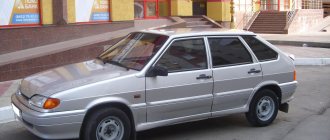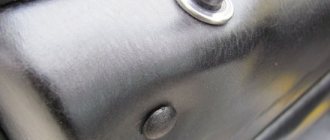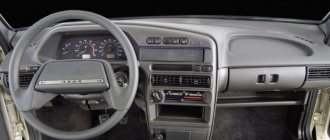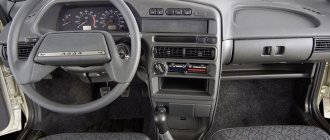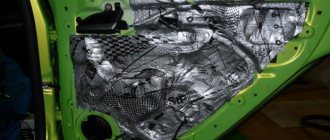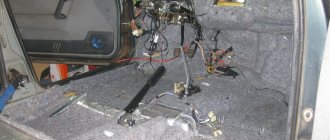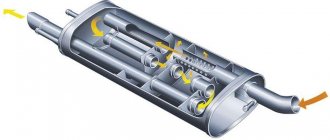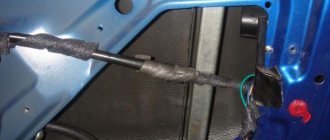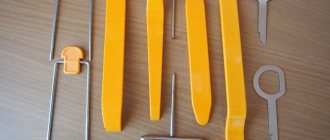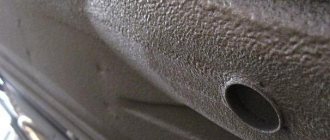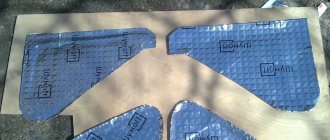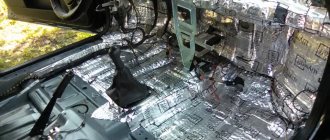Sheet selection
You must immediately understand that for different parts of the interior, it is necessary to use different materials. And that vibration isolation is not the same as heat and noise insulation. The noisiest part of the VAZ 2114 is, of course, the engine compartment and the gearbox tunnel. This also includes the wheel arches, namely the pillars. It was chosen to glue StP Bimast bomb Premium on them. I got 4 sheets. iSilver 30 was placed on the floor of the cabin. It took 12 sheets. iSilver 30 10 sheets were used for the doors and ceiling and hood. A Barrier 8 x 2 sheets for the ceiling was purchased. and BiPlast 10K to eliminate crickets. There is the same material, but with tape. It turns out more expensive. It’s easier to take one leaf and have someone cut it into strips 1-1.5 cm wide. The most Jewish part of the purchase! As a heat and sound insulating material, we chose a simple roll on the construction market. Its price is 1000-1200 rubles. Moreover, there are 30 square meters. In the end, it was left for gluing the roof))) According to the receipt 6725 materials StP + 1100 rubles market.
Preparing for work
- The first thing you need to do is choose clothes. Take something you don't need. You will 100% get stuck in bitumen from the edges. It's hard to peel off. I advise you to do all this in slippers, for the convenience of jumping in and out of the car.
- Tools. You will need a roll of fabric towels and a solvent (White spirit) to degrease surfaces. Set of keys: Heads for 10, 13, and a slotted Zhiguli key for removing seats. Choose from a screwdriver or screwdriver. Table spoon, for smoothing vibration-absorbing materials. A sharp construction knife, preferably 2 at a time if a group of people will be working. Rubber gloves for working with solvents. A friend spilled it on his hands, after about 20 minutes there were minor burns from it. Double sided tape. If desired, buy phosphoric acid with zinc. The price is 200 rubles at the construction site. Rust remover. Works great. It is better for her to remove the found spots during her work to avoid the germination of rot under the insulation.
- A bunch of bags. Do not be surprised. Place each interior section, screws, nuts, washers in a separate bag and label it. Better yet, take a photo of where it’s coming from on your phone. Believe me, this will cut the interior assembly process in half, or even three. Be sure to take pictures of connecting all the connectors to the buttons and so on. Otherwise, you’ll get yourself a bunch of hemorrhoids if you don’t understand wiring.
Pasting materials
Vibro
The work is painstaking. Since the vibration isolator is placed first. And it should follow the shape of the body. This is where you need a spoon. It's very convenient for her to iron everything. Advice! Immediately where you see, cut technical holes. Then you simply won’t find it. All surfaces are first wiped with a solvent in order to clean them and degrease them. The most difficult part was pushing that same Bimast under the standard insulation in the engine compartment area. Since we did not remove the torpedo. Two of them were holding their native Shumka, my friend and I were ironing it. They also placed bimast on the box tunnel, since it produces a lot of crunches and vibrations. It is better to work with it by pre-heating it with a hair dryer. It will become much softer and more pliable. There were no problems with the rest of the cabin. I would like to note that it is simply not even necessary to paste over absolutely everything, without small gaps between the sheets. This material acts as a vibration dissipator. And based on the physics course, if you take a square sheet and paste it 80%, you will not see the difference from 100% pasting. In the photo below you will see that in some places we neglected accuracy.
Thermal noise
It's much easier here. It doesn’t matter at all whether this material will lie perfectly following the shape of the body, or whether you throw it away, securing it with double-sided tape. Again, let's call on physics, air dampens sound and retains heat. So the gaps between the heat noise and the vibration are even useful. Remember about technical holes!
Separate doors
The most convenient way is to glue exactly 1 sheet of iSilver 20 to each door, then use the trimmings on the trunk, for example. I advise you to invite a friend with thin long arms. To glue doors through technical slots. Give him gloves, otherwise he will cut all his hands with the edges of those very holes. We carefully glued only the driver's and passenger's doors from the inside. They glued them inside the rear ones as best they could. The anti-corrosion coating on the doors will still have to be thoroughly wiped off. Don’t be afraid where you erase it, cover it with bitumen. Therefore, nothing will start to rot there.
A few words about the hood
Vibra should be glued only according to the shape of the slots. And cover the top with one sheet of Shumka with double-sided tape.
How is the sound insulation process performed?
We completely disassemble the interior of the car, remove the seats, carpet, door trim, dashboard and ceiling. We remove everything that covers the metal. Only the handbrake should remain on the floor.
After that, take a rag, water and wash everything thoroughly. There shouldn't be any dirt. We also wash the doors. In addition, it is necessary to degrease everything. White spirit or brake cleaner works well for this.
First of all, we glue vibration-proofing material. It must follow all areas of the body and must be glued well. We use a hair dryer and a smoothing roller to ensure that the material sticks tightly. Important advice - if there is a technical hole, it is better to make it in the vibrating material right away, otherwise problems will arise later.
Interior assembly
The most difficult part of the whole process. No matter how hard you try, the thickness of all surfaces has increased. And everything will have to be attracted. First, we return the standard sound insulation to its place. Then panels and parts. We glue the same strips of Biplast on the edges of the door panels. They will remove all the creaks of panels on the iron doors. I glued them in the places where the rear window sills were attached.
We started collecting from the trunk, moving forward. The driver's seats were installed last. Two men had to stand on them to make it possible to pull them down. There are "springs" under the seats. Remember how they stood and how the hooks to them stood. Because if the fastening is incorrect, you will not be able to move the seat. Remember about the bags)))
Results
There were 5 of us. We had a bunch of sheets of different insulation, one box of beer, 8 packs of cigarettes, 20 packs of Rolton, 4 Coca-Cola, one cat and one dog))
Seriously, the whole process took 3 days. With smoke breaks and even pauses for light rain.
About the result: I’ll say heaven and earth right away, of course. We went to New Riga to check the quality of our work. The vibrations and squeaks of the gearbox have disappeared. Vibration and engine noise in the cabin have been significantly reduced. The wind no longer howls at 100 km/h. Vibration is also not felt from a passing truck nearby. The interior heats up 2 times slower in the heat. Since, already in winter, the stove warms up noticeably faster and cools down for quite a long time.
The music began to sound much cooler. Most importantly, the roof became completely blank. The sound of rain disappeared completely. In the cabin you can’t hear the keys being thrown onto the roof, for example. On gravel the noise from the wheel arches has decreased. The doors have become heavier, making them softer and easier to close. In general, the general impressions are comparable to the average foreign car.
Sound insulation of front doors
Good day to all!
This time we will talk about soundproofing the front doors, as I said in the previous BZ. For me, this matter turned out to be not so difficult and complicated, but tedious, especially considering that my bast shoes are healthy and they were sooooo cramped in the door. Well, let's start with the material I used: 1) M2 Vibration isolation SGM - 3.7 sheets
3) Bitoplast - 2 sheets (1x1.5)
4) Madeline - 1 roll (1m x 40cm)
I found a photo of the materials on the Internet, so don’t judge strictly, I only have one photo of the material itself, but it’s not clear what and where)
Something like this))) well, oh well. Since after installing the Euro handles I did not assemble the doors, this reduced the work a bit, the first thing I did was remove the protective covers in the door itself and wiped the doors inside as thoroughly as possible; to my surprise, there wasn’t that much dirt. After washing the dvikeys, I cut one sheet of vibration isolation into strips of about 13 - 17 cm, and began to paste over the door, where possible I pushed it behind the amplifier, I didn’t time the time, but it took quite a bit, since I was doing this for the first time, I smoothed it with my hands and heated it with an ordinary home hairdryer, the result of the first standing in the photo:
After I finished with the vibration, the splen layer went on, approximately according to the same pattern
after that I sealed the wires, rods and places where the casing would be attached with malelin, and closed all the holes except for the speaker
and finally a layer of bitoplast
second door in the same way
this is how I spent the weekend) Tell me honestly, all my hands were killed even after installing the handles, and with this procedure I actually mutilated them all, a lot more scratches and bruises) but it was worth it) Even with the rear doors disassembled and made up, I can already clearly hear the result , and how they close now, I actually enjoy it) Well, I described it as best I could, thank you all for your attention!) In the coming days, the second part of the sound insulation will be the rear doors) If you don’t understand anything, ask me, I don’t bite and I will answer all your questions) Smooth roads to you! )
Source
Do-it-yourself noise insulation of VAZ 2114 according to instructions
How to make sound insulation in a VAZ 2114
Do-it-yourself soundproofing of the VAZ 2114 has the most important goal - to reduce the level of audibility of extraneous sounds in the car interior. Noise comes from the power unit, the wind outside when moving quickly, and other sources.
If you know how to make noise insulation for a VAZ 2114 yourself, you can significantly reduce the noise level and save a lot of money at the same time, since services of this kind in service stations are not cheap.
General information about the process
The initial one is provided by the manufacturer at the stage of assembling the machine. But gradually, due to temperature changes, any material loses its beneficial properties.
Before you start carrying out the “Shumka” on your own, it is recommended to dismantle the seats, door trims, mats and free the car from the old standard insulation.
Note : Only by carrying out a complete and thorough soundproofing procedure can one hope for a significant reduction in noise from the outside. Only in this case will the cabin be perfectly quiet and comfortable.
Soundproofing panel VAZ 2114
It is especially important to treat doors, as they often become the main installation location for speakers. It is clear that this place should be well protected not only from noise penetration, but also from plastic vibrations and other negative phenomena.
Acoustic speakers in the doors
Along with sound insulation, the interior will also receive high-quality insulation. In Russian conditions this is extremely important. To achieve this effect, you need to combine vibration and sound insulation.
Soundproofing for VAZ 2114
“Shumka” carried out on a VAZ 2114 is often called tuning. This is true, because a real modernization of the car is being carried out. Operational parameters are increased and comfortable conditions are created when the vehicle is moving.
The driver is no longer oppressed by engine noise, his nervous system is not irritated by the strumming and vibration of plastic elements. All this cannot but have a positive impact on overall driving safety.
As mentioned above, the standard “Shumka” will not be of good quality; relying on it is the last thing. The process of carrying out “Shumka” on cars with high mileage is especially relevant. In general, such cars are very difficult to drive, since the noise penetrates everywhere, interferes with the normal operation of the acoustics, creates complete discomfort, and the trip turns into a very tedious task.
On sale today you can find a sufficient amount of high-quality materials for carrying out “Shumka”. There are a lot of them and making the right choice can sometimes be extremely difficult. One of the main indicators of a good material is not only the ability to absorb sounds, but also to be light in weight (details about materials in the table below).
Note. If the material itself is heavy, making noise will be difficult. As a rule, good and proper insulation involves laying several layers of material, a kind of sandwich consisting of layers of vibration and noise absorbers. Heavy materials will create excess weight that is dangerous for the car and its body, which will inevitably affect fuel consumption and the overall dynamics of the car.
Splen with foil
Among other things, you also need to lay out materials skillfully. The fact is that if you don’t pay attention to this, the materials will simply turn into a time bomb for the metal component of the car.
Poorly laid material creates gaps through which air, moisture, etc. will penetrate. And all this will inevitably lead to the appearance of the most terrible enemy of the body - corrosion.
Correct installation of the material always means following the instructions in a step-by-step sequence, using the right tools, using a hair dryer and much more.
In some cases, especially when carrying out the noise yourself, partial sound insulation is also appropriate. In this case, the target is the most noise-producing parts of the machine. Definitely the doors, then the trunk, the rear parcel shelf, and so on.
It is important, when working on your own, not to damage the upholstery. Unfortunately, this often happens due to the inept actions of the car owner who is carrying out such an operation for the first time. In general, conducting a “Shumka” is a painstaking and lengthy process, but it’s worth it.
Before carrying out soundproofing, it is recommended to carry out a partial or complete inspection of the machine. The causes of all vibrating and knocking sounds produced by suspension elements or other vehicle components must be eliminated. They may be loose or need to be replaced. The body and its parts must also be checked.
Algorithm for carrying out an operation to “shumka” a VAZ 2114 car
To isolate the interior from excess noise, you need to carry out soundproofing by following these step-by-step instructions:
- First, disassemble the car, removing those parts that make noise when driving. These could be mudguards, arches, fenders, etc. It is advisable to cover them from the inside with some kind of vibration-damping material;
- The seats will also need to be removed if the interior is fully soundproofed;
VAZ 2114 sound insulation of the panel and the interior as a whole
- Cover the floor of the car with a vibration damper and roll it in with a special tool.
Advice. To ensure that materials adhere better to metal or plastic, it is recommended to carry out work in a dry and warm room. In a damp room, it is better to preheat the foil with a special hair dryer, and only then roll it onto the surfaces of the body.
Soundproofing torpedo VAZ 2114
- The next material, as a rule, is Spleen. It has a sticky base, lays on surfaces easily, and perfectly cuts out excess noise penetrating from the outside;
- To install materials in the trunk, the lid is removed in advance, all screws and bolts are unscrewed.
Soundproofing the trunk of a VAZ 2114
Note. In general, disassembling the luggage compartment involves a separate operation. Here you will need to prepare everything thoroughly, disassemble the compartment down to the bare metal surface, pull out all the wires going into this area. As for laying materials, only clean and dry surfaces should be processed. After the material has been laid, you will need to put the wiring back in and close all the extra holes.
VAZ 2114 trunk sound insulation
- Door treatment (see Soundproofing VAZ 2114 doors can be easily done independently) is practically the most important procedure in terms of increasing the so-called “acoustic” properties of the interior. It is recommended to insulate these parts of the car with a good polyurethane-based material. The front doors of the VAZ model, which are entrusted with the role of a stand for acoustic speakers, are recommended to be rolled in two layers.
Note. In fact, the “noise” of the door also involves the initial disassembly of the upholstery, gluing both sides and the card. Door technological openings are closed only on one of the edges.
- The roof of the VAZ 2114 is also treated. In order to fully carry out the “noise” of the car ceiling, you will need to remove everything, from the mirrors to the upholstery;
Soundproofing the roof of a VAZ 2114
- No less valuable in terms of protection from the penetration of external noise and sounds of the internal combustion engine is the hood. You also need to be able to process it competently.
Sound insulation of the VAZ 2114 engine compartment and hood
Sound insulation of doors VAZ 2113, 2114, 2115
Sound insulation of car doors VAZ 2114, 2113 and 2115 plays an important role in increasing driving comfort. It allows you to solve the following problems:
- significantly reduce the level of noise entering the interior from the street;
- eliminate knocks and creaks produced by internal parts and parts of the door trim;
- improve the sound quality of music in the cabin, especially if the speakers are built into the doors.
ATTENTION! Now you can buy a completely new Pioneer MVH X580BT processor radio for only 2990 rubles! Don't believe me? Then follow the link and see for yourself! Read more"
Soundproofing the doors of VAZ 2114 , 2113 and 2015 can easily be done with your own hands. The materials used are relatively inexpensive and can be purchased at almost any auto store.
The recommended standard sound insulation of the front doors of VAZ 2114, 2115 and 2113, which, as practice has shown, gives a fairly good result, consists of the following steps:
Disassembling the door. Removal of the casing and subsequent disassembly must be done extremely carefully. It is important to remember (or better yet, write down) the sequence of operations, the correspondence of the unscrewed bolts and screws to their holes. For convenience, you can lay out the parts on a large surface in order of disassembly. The door closing mechanism and the window lift do not need to be removed - they will not interfere with the work, but putting them back is quite difficult.
Cleaning the inside surface of the door. It is necessary to remove the factory sound insulation and other coatings that may peel off (anti-corrosion coating, etc.), but it is important not to scratch the paint. The surface of the metal must be thoroughly cleaned and degreased - for this it is recommended to use White Spirit solvent; the very bottom of the door does not need to be degreased.
Sticker of the first layer of soundproofing material. The inner surface of the panel (the wall of the door facing outwards) is pasted over with vibration-damping material (self-adhesive Vibroplast Gold STP or its equivalent is recommended) - pieces are cut approximately in the shape of the contours to which they will be glued. This work, of course, is not easy - you need to contrive to stick “Shumka” through the openings of the technological holes, which is quite inconvenient, especially in the far corners. To avoid cutting your hands, it is advisable to work with gloves, using available means for pressing the material to the surface - a rolling roller (where it can be reached), flat tools, wooden blocks, etc. Where it is impossible to glue whole pieces, you can glue individual pieces overlapping each other, you need to cover as much surface as possible. When sticking Vibroplast, it is important not to close the drainage and ventilation holes so that condensation does not accumulate inside the door. If a circle cut from Bitoplast is glued behind the speaker on top of Vibroplast, the sound quality will improve, since the speaker will not resonate with the door.
Elimination of knocking and creaking of parts of the internal “stuffing” of the door. It is advisable to wrap all kinds of wires, rods, etc., located inside the door body with Madeline so that they do not knock when shaking; we pay special attention to the places where they come into contact with the body - here they can be wound in two layers. It is also very useful to make a Madeleine gasket along the contour of the door where the trim is attached.
Vibration isolation of technological openings. Factory-made holes are sealed with the same Vibroplast (pieces in the shape of the holes with an allowance of material along the contour for gluing).
Then it is recommended to cover the metal surface of the door on the trim side with Accent sound absorber or at least Bitoplast 10 mm thick. You should try to cover this surface completely, bringing the wires out (if any) and leaving the speaker exposed. Before this stage, it is necessary to check the serviceability of the lock mechanisms and window regulators, tighten the fasteners and, where necessary, apply lubricant.
Soundproofing of the casing. To reduce vibration and sound resonance of the casing, it is recommended to stick pieces of a vibration damper on it (preferably Vibroplast Gold) - not necessarily on the entire surface, so as not to unnecessarily weigh down the door - it is enough at the joints of the casing parts and on wide, flat areas.
Door assembly. Assemble the door, observing the correct sequence of operations. When installing the casing, replace the pistons with new ones or fasten it with self-tapping screws, where possible.
Soundproofing of doors 2114, 2115 and 2113 (rear doors and doors without audio system speakers). The technology described above is recommended for soundproofing doors that have powerful speakers installed. For doors without speakers or with low-power speakers, this procedure can be significantly simplified - just stick a layer of Vibroplast onto the panel and door trim, and also wrap the sealant around the wires and rods inside the door body.
When installing sound insulation, it is not recommended to use heavy materials - they increase the load on hinges and locks, which can lead to their deformation and problems with closing doors in the future. To increase the effect of sound insulation, it is also recommended to improve the door sealing - update the door seals or replace them with higher quality analogues.
In conclusion, it should be noted that sound insulation of the doors of VAZ 2115, 2114 and 2113 will give the desired effect only with an integrated approach, that is, if other parts of the interior are modified accordingly: hood, roof, floor, trunk, etc., otherwise on its own this operation does not make sense.
Processor radio Pioneer MVH X580BT for 2990 rubles!
One of the best radios in its segment. It is a diskless receiver that rationally uses the manufacturer’s developments in the field of digital audio processing. This is a full-fledged processor device, designed taking into account the needs of modern car enthusiasts. More details at the link.
- Matrix LCD display with wide viewing angle;
- Working with a USB drive;
- Built-in microphone, Bluetooth and wireless voice communication system (can connect up to 2 phones);
- Compatible with Android, iPod/iPhone;
- Maximum output power: MOSFET 50W x 4.
Find out details
Useful tips
Today, many owners of the VAZ 2114 install new acoustics in the car, more powerful and productive. They buy an expensive subwoofer (see 1000-watt subwoofer and a review of the best models), a powerful amplifier (see The best amplifier for a subwoofer and how to choose it) and a lot of other useful things that significantly increase the level and quality of sound. But imagine their disappointment when all the money spent turns out to be thrown down the drain, since the sound still leaves much to be desired.
It turns out that the whole point is insufficient insulation of the car body panels, through which noise penetrates from the outside. It’s no longer possible to enjoy clear sound: rattles, vibrations, knocks - all this degrades the quality.
As mentioned above, car doors are very important in this regard.
Here's what you need to focus on:
- They must be insulated on both sides, although excessive zeal should not be shown either. Heavy doors mean they may sag over time;
Sound insulation for VAZ 2114
- In addition, we must take into account the fact that the doors of the VAZ 2114 are often covered with cellophane. The latter makes unpleasant sounds and creaks in the cold season in the frost;
- It is advisable to lay materials on the door in large pieces (as much as possible). The materials used should not be visible beyond the edges of the sheathing.
It’s not difficult to learn how to carry out “Shumka” with your own hands. Step-by-step instructions, photos, materials, and videos will help in this matter. The factory standard insulation must be completely stripped off so that new materials can be installed efficiently.
Do-it-yourself soundproofing of front doors
Good day!
Plans for sound insulation were written earlier in the BZ, my job was to take and make the front doors noisy, the rear doors would also be noisy, but we ran out of material in our city. And so according to plan, as he made noise with the photo report. I will write what problems I encountered and how I solved them.
— Opposite the speakers I glue a circle of Bitoplast so that the speaker plays better and is not affected by sound waves reflected from the door;
— I check the functionality of the door opening mechanism and window regulator;
Everything was supposed to be like this according to plan, but here are my problems that needed to be solved: 1. when dismantling the casing, the fastening of the pistons broke off
2. two layers of bitoplast on the door and on the trim did not work as planned on my VAZ 2114
3. I didn’t fully cope with the third task, these are insignificant caps that the market offers us
I was not able to install the casing with Togliatti pistons for one simple reason: if the “father” does not fit into the “mother” it breaks and there are no options; if I can install it, it seems to hold, but I had to dismantle it, I couldn’t install anything else with them.
I refused to use splen in the front doors; for me, the priority is sound quality and the absence of squeaking.
As a result, the “noise” of the doors in the car has become slightly quieter, the doors are easier to close due to the increase in weight, and the sound of the acoustics has become more pleasant due to the closed space in the doors. Satisfied.
For soundproofing material on the front doors along with splenium (although I didn’t use it) I paid two thousand and kopecks, a ruble for the door))))
The calculation of the material for one door is as follows: Vibroplast 2mm - 2 sheets Bitoplast 10mm - 1 sheet
photo of the interior of a bathroom in an apartment
I’ll clarify the name of the materials and dimensions, because I bought an analogue of these materials, apparently the factory has a different name, too.
I hope my post will be useful to those who are planning to do this.
Source
Table
Materials for vibration and noise insulation:
| Vibration isolation | Sound absorbers | Sound insulators | Anti-creak |
| Designed to reduce the level of vibrations emitted by the most important components and assemblies of any car. These include the engine, transmission, and wheels. The most important places for vibration isolation of a car are the wall of the engine compartment and wheel arches. The listed elements must be especially carefully glued with vibration-absorbing materials. | Provide excellent noise absorption performance. Figuratively speaking, they “absorb” all sounds and “destroy” them, preventing further propagation of the sound wave. The materials have an adhesive layer and an open porous structure, and are glued directly to the vibration. The main effect in car sound insulation comes from materials in this category. | A material used when carrying out soundproofing work on a car, the main task of which is to isolate it from external sounds. The distinctive ability of a sound insulator from a sound absorber is that the insulator, simply put, reflects the sound wave (that is, sends it back), and the absorber “absorbs” and “destroys” it. | This type of material, as the name suggests, is designed to successfully combat sources of squeaking - parts rubbing against each other. |
| Materials: | Materials: | Materials: | Materials: |
| Bimast Bomb STP | Bitoplast | Splen | Bitoplast 5-10 mm |
| Bimast Super | Accent | Noiseblock STP | Madeleine |
| Bimast Standard | Isotone | ||
| Vibroplast Gold STP | |||
| Vibroplast Silver STP | |||
| STP Aero | |||
| Vizomat PB-2 | |||
| Vizomat MP |
Soundproofing VAZ 2114: do it yourself
VAZ-2114 has a high noise threshold. While the vehicle is moving, the driver and passengers are forced to hear extraneous sounds. Sources of noise can be the power unit and even the wind. It’s difficult to call such a ride comfortable, so owners of domestic cars sooner or later think about how to soundproof a VAZ-2114 with their own hands.
Car maintenance yourself saves a lot of time and money. With a little experience and knowledge in repairing the VAZ-2114, you will always feel confident on Russian highways. Moreover, domestic cars seem to be created for studying the internal structure of the structure - mechanics allow you to independently eliminate almost all problems of the components.
Newbie car enthusiasts are wondering: how long does it take to install sound insulation? If you do everything slowly and in accordance with the instructions, the work can be completed completely in 5-6 hours. As a result you get:
- maximum reduction of noise entering the vehicle interior from outside;
- clear sound of the audio system;
- To listen to your favorite song while drowning out external noise, there is no need to turn up the volume.
Preparation
First of all, it is necessary to prepare the car interior for installing new sound insulation by dismantling all removable parts: seats, mats, panels. We carry out this procedure step by step:
- remove all seats:
— unscrew and remove the trim from the B pillar and door sills;
- remove the air ducts:
— carefully remove the carpet and coverings (we will need them later):
— remove the foam cushions to level the floor;
— remove the factory sound insulation:
After removing all removable parts from the interior, you must wash the floor thoroughly and thoroughly go over the metal with a degreaser.
It should be noted that in domestic cars, the drain holes at the bottom of the body are not sealed with plastic plugs, and water often enters the interior through them during bad weather. Therefore, before installing sound insulation, you should think about high-quality sealing of these holes.
Required tools and materials
To achieve good sound insulation, you need to prepare a whole set of tools and materials in advance:
- Stroyizol SD 90 grade.
- Splen marked 3004.
- Accent 15 LM KS.
- Be sure to buy vibroplast type Gold.
- Adgilin.
- Vizomat MP.
- Stock up on a metal ruler.
- A construction tape measure won't hurt.
- Square.
- Hairdryer, preferably a household one.
- Montage.
- Screwdrivers with different tips.
- Awl.
- Keys.
- Sharp scissors.
Step-by-step instructions for arranging sound insulation for the VAZ-2114
It is necessary to begin arranging sound insulation in the cabin with a general cleaning of the car. Clean the internal structure from dirt, remove excess layers of materials from the vehicle, for example, upholstery, panels, as well as those parts that may cause extraneous sounds - mud flaps, fenders, arches.
Nothing significant can be done with them, but it is preferable to cover the inside with vibration-damping material.
What to do next:
- Remove the seats.
- Visomat MP is characterized by the absorption of vibration noise, so treat the entire plane of the trunk floor with it. This method also makes it possible to strengthen the rigidity of the machine; noise waves move to the lower, inaudible frequency range. Experts say that sticking Vizomat MP retains heat in winter frosts and at the same time keeps cool air in the car in the summer heat.
- To properly and reliably glue Vizomat MP, you need to use a household hair dryer. First, wait for the material to soften and become elastic and only then proceed to process it with a warm air stream.
- A dry and dark room for repair work is an important requirement to obtain the desired result. It is unlikely that it will be possible to heat the foil to the required temperature in a damp and cold room.
- Vizomat MP is adjusted to the outline of the body component immediately; fixation must be done quickly, otherwise the material will not fit tightly. With this quality of gluing, you can’t expect significant sound insulation for the VAZ-2114. You shouldn’t rush either, otherwise the material will set, but will not meet its characteristics.
- If there are no large sheets available, you can lay the panels overlapping each other, one sheet should overlap the other at a distance of 15-20 mm.
- It is forbidden to seal technological recesses, components responsible for fixing parts, and hatches with Vizomat MP - after completing the soundproofing of the VAZ-2114 with your own hands, you will still need free access to these parts.
- Vibration insulation should ideally be maximum; for this, not only the floor, but also the ceiling surface should be covered with noise-insulating material, and approaching the dashboard is encouraged.
- If you decide to additionally soundproof the car interior, then the soundproofing layer must be laid on top of the soundproofing layer. Drivers who have done sound insulation with their own hands note that heat is retained in the cabin, which is impossible not to notice in winter.
- Splen, on the one hand, has a sticky layer, so it sticks on its own and is fixed without effort. To cover the trunk with Splen, you need to remove the cover, unscrew the screws and bolts. What does it mean to disassemble the trunk? After dismantling, only bare metal remains; the wires located in this part of the machine are also removed. After laying the material, do not forget to re-arrange the wiring and cover the holes.
- Door processing requires polyurethane-based material. Experts recommend treating the front doors of the car with the material in 2 layers.
When material is considered to have been installed poorly:
- If there are gaps, cracks through which air enters the car interior and corrosion processes are accelerated.
- The doors, trunk, and rear shelf should be treated (the latter makes a strong vibrating noise).
- Damage to the upholstery is what you need to watch out for when fixing the Vizomat MP, if you are not tolerant, do not like monotonous work and are annoyed by doing your own car repairs, it is better to leave the sound insulation of the VAZ-2114 for professionals.
- When starting to modernize the VAZ-2114, it is advisable to conduct a preliminary thorough inspection of the sources of vibrating and knocking noise - special attention should be paid to these details.
If the components are poorly secured, this defect must be eliminated. It happens that the element is completely worn out, and no matter how much you would like to get rid of the noise, other than replacing the part, there is no other way to solve the problem.
How many sheets of sound insulation are needed for a VAZ 2114
Domestic cars have never been famous for good sound insulation of the interior, as well as for a huge number of creaks and rattles throughout the cabin, and this VAZ 2114 was no exception. In order to reduce noise from the road surface, improve the thermal insulation of the interior, and also get rid of squeaks, work will be done additional sound insulation of all doors, roof, floor and trunk with arches.
Sound insulation level Normal.
Significantly reduced noise, eliminated squeaks, better heat retention in the cabin and an affordable price.
Material used for sound insulation: M2-62 sheets 3720 rubles M4-56 sheets 5040 rubles P4-8 sheets 800 rubles P8-10 sheets 1800 rubles Germeton 7-2 sheets 1440 rubles Bitolon A15-4 sheets 1040 rubles Total: 13800 rubles.
Sound insulation of VAZ 2114 doors.
anti-squeak material Shumoff Bitolon 5.
Soundproofing the roof of a VAZ 2114.
As we can see, the standard sound insulation on the roof of the VAZ 2114 is completely absent.
Soundproofing the floor of VAZ 2114.
Sound insulation of the trunk and arches of the VAZ 2114.
As vibration insulation for the bottom of the trunk and arches we use thick vibration insulation 4mm thick Shumoff M4
. Like all vibration insulation, we warm it up in a special stove before installation, and carefully roll it after installation.
This arrangement of materials will allow you to achieve maximum efficiency while maintaining the factory quality of the interior assembly.
All that remains is to restore the interior to its original form. The work required 8 hours of working time and 3 craftsmen. Cost 22,000 rubles.
Our Website Omsk
Phone: +7962 031 8837 Address: Zavodskaya 34a/1
Novosibirsk city
Phone: +7960 798 1403 Address: Fedoseeva 36/3 k1
Many people wonder how much material is needed to soundproof a car. Of course, every car is different and requires different amounts of material. In this post I will give an example of how you can measure a surface and calculate the material; I understand that many people know how to calculate. But there are those who don’t know. I will also give specific figures for the actual calculation of material for the VAZ 21099. Everything was tested myself on my car.
First you need to decide what you want.
1. How many layers of material will there be?
2. Which material should I choose? 3. What parts will be glued, with what and for how long? 4. How to use all this? Here you need to decide. The materials are: vibration-absorbing, noise-absorbing, noise-reflecting, anti-creaking.
If you are satisfied with the external noise in the car, but there are vibrations or you need to add rigidity to the elements. Then you just need to glue the car with Vibration Isolation. Some noise will also be removed.
If there are creaks, vibrations, rattles, extra noise. Then we will talk about multilayer insulation.
Many people glue their cars in 2 layers. It is also possible in 3. This does not mean that they glue the same material in one place 2-3 times. And they use different materials and the result is a sandwich of layers.
Gluing in 2 layers: vibration material + noise-reflecting or absorbing.
Anti-creaking gasket materials are also used. Sizing in 3 layers: vibration material + noise-reflecting + absorbent. Also anti-creaking. It depends on your capabilities and needs.
Of course, 3 layers are better, but the thickness will be greater. It is optimal to glue in 2 layers. 2. Which material to choose
There are many companies in the market.
For me personally, the big factors are: price, quality, manufacturability. So my choice immediately fell on the SGM company (SGM Techno). They have a wide range of materials, at good prices, large sheet sizes and high quality material. Also, STP is probably a leader in this area. But the prices for the material are steep. To summarize:
Vibration-isolating material:
SGM 500x800mm Price: 130 rubles M1. 150r M2. 200r M3. 270 M4.
Noise-reflecting One of the easily accessible ones is Splen, also known as isolon.
1000x1000mm 4mm 150r; 8mm 300r This material, thanks to its foam structure, reflects noise well and retains heat. Also moisture resistant
Noise-absorbing Also the material is well advertised - Accent
Photo report on soundproofing the two front doors of a VAZ 2114 using the StP Premium line of materials.
The winner of our last competition, Viktor Vladimirovich, received his prize!
This is a poster for a past draw.
StPbox70 fulfills its obligations, which means that every client leaves us satisfied!
Follow our news and wait for the next draw!
First layer of STP Aero
We seal up the door space as much as possible
Second layer of STP Accent Premium
Accent Premium is an excellent sound absorber that is well suited for the inside of the door.
We also carefully roll up the entire possible area.
We handle the design carefully.
Third layer of STP Aero - seal all the holes as much as possible.
The reflections show the good quality of the roller sealing.
A prerequisite with the Russian auto industry is that we change all the clips for new ones!
The fourth layer of Biplast Premium is applied to the entire surface of the door card.
Comments (0)
Please log in to post a comment. Before entering, you must be registered on the site.
Important information
5 Interesting Ways to Use Vibration Absorption Materials
It may happen that after soundproofing the car, when the interior is already assembled, a little vibroplast remains.
How much material is needed for sound insulation?
How much sound insulation you need to purchase is, perhaps, the main question of a person who comes to our StPBox70 service. Often the choice is made based on budget, after we show all the materials and explain their good and bad sides.
Sound insulation of the VAZ 2114 engine compartment, as well as the body
The main task of sound insulation in a car interior is to reduce the audibility of sounds made by the engine, wind, and other extraneous noise. Sound insulation of the VAZ 2114, like other models of this family, is provided during assembly at the factory. But over time, under the influence of high temperatures and painting, it loses its insulating properties.
If it is not possible to undergo service, then you can install the Shumka on the VAZ 2114 with your own hands, in which case it is necessary to empty the interior of seats, rugs, door trim and old factory sound insulation. The car will be quiet and comfortable only with complete and thorough insulation of the doors, arches, fenders, hood, trunk, roof and floor. The doors are insulated to improve the quality of acoustics; the sound of a running engine will not be heard after the hood is insulated.
You can not only improve the sound quality of the acoustics, but also insulate the interior if you combine vibration and sound insulation during gluing. The process of preparing for dismantling consists of selecting the necessary tools for removing the casing. Removing upholstery material from the floor and ceiling will not be difficult, since the interior trim and seat mounts have a fairly simple design.
How to install sound insulation in the interior
Regardless of the materials used, installing sound insulation on a VAZ 2114 with your own hands is very simple - most of the time will be spent on dismantling the elements of the internal cladding than on installing the insulation itself.
In order to install it, you will need to prepare tools such as:
- square;
- roulette;
- ruler (preferably steel);
- mount;
- construction hair dryer;
- awl;
- a set of keys;
- knife;
- screwdrivers with straight and Phillips slots;
- scissors;
- roller for rolling.
In addition, you will also need a composition for degreasing metal surfaces (acetone is perfect for this role, although specialized products can also be used).
As for insulating materials, you can buy them at a hardware store.
The most commonly used for such tasks are:
- Vizomat MP (vibration and thermal insulation);
- Accent 15 mm (sound absorption);
- Splen (thermal insulation).
Splen for VAZ 2114
The very sound insulation of the VAZ 2114 interior is performed as follows:
- Remove all foreign elements that may interfere with the operation, including seats, panels, trim, handles, etc.
- Remove factory sound insulation.
- Clean all metal surfaces of the interior frame and degrease them.
- Heat the entire surface of the Visomat using a heat gun and only after it has warmed up evenly, remove the protective film from it and quickly stick it on the metal surfaces of the interior.
- Roll the Visomat using a special rubber roller.
- After Vizomat has been applied to the entire surface, stick a layer of Accent on top of it.
- Glue the third layer of Slam on top of the Accent.
- Reinstall all dismantled elements into the interior.
At this point, the installation of Shumka inside the car can be considered complete.
When applying sound insulation, it is important to ensure that the joints of the layers (this especially applies to the first vibration-protective layer) are fitted as accurately as possible. It is recommended to use the pieces themselves as large as possible - all this will ultimately increase the sound suppression properties of the finished Shumka.
The main role of sound insulation
Soundproofing a VAZ 2114 car is a kind of tuning. Every driver wants to improve the performance of their car and create comfortable driving conditions. The noise of the wind, the running engine, studded wheels and rattling in the trunk depress not only the driver, but also the passengers in the cabin.
As already noted, the sound insulation of the VAZ 2114 car is not of high quality; within a couple of years after purchasing a new car, installing a noise isolation system is simply necessary. Extraneous noise penetrates everywhere, interferes with the purity of the music and creates some discomfort, making the trip long and tiring.
There are plenty of sound-absorbing materials on the market today. The main thing is that they must be of high quality and light. To prevent corrosion, there should be no air, bubbles or gaps underneath them. The tools are standard and can be taken from a car kit. If you need to heat the material for fastening, you can use a hairdryer.
Shumka VAZ can be carried out partially. It usually affects the trunk and doors. The instructions for carrying out insulation are simple; the work can easily be done with your own hands. To soundproof your car, you can also use the services of a car service.
Soundproofing a VAZ 2114 with your own hands will significantly save costs, although the process of disassembling the car is quite lengthy and painstaking. When disassembling, it is important not to damage the upholstery in the cabin. If everything is done correctly, the car will become much more comfortable.
There is a misconception that noise in the cabin is caused by the suspension. Of course it's worth checking out. But in fact, a common cause is precisely poor insulating material, the quality of which almost all VAZ models cannot boast of.
Installing Shumka in other compartments of the car
In addition to installing sound insulation inside the cabin, it is also recommended to install it under the hood (which is especially important, since a properly installed noise insulation can significantly reduce the audibility of sounds from a running engine), in the trunk, and also in the doors. The process of installing insulation is completely identical to its installation inside the cabin - you will need to apply three layers of the same materials as mentioned above.
Soundproofing the hood of a VAZ 2114
The only thing you should remember is that the sound insulation of the doors of the VAZ 2114 must be done most carefully, since the quality of the audio system installed in the car directly depends on it.
For these purposes, it is recommended to use the more expensive, but also much more effective vibration damping material Shumoff P4 (it is applied as the first layer instead of Vizomat). In addition, it is recommended to additionally cover all plastic door elements with anti-squeak coating Bitolon 5.
Soundproofing doors VAZ 2114
When performing noise insulation work, all technological openings, passages for laying wires, hatches and other cavities should be left open. They should absolutely not be sealed with insulating materials.
Thus, almost every driver can independently install effective and inexpensive sound insulation - you just need enough patience and free time to complete this work.
How to soundproof a car interior with your own hands
To isolate the cabin from unnecessary noise, the following simple instructions will help.
- The car is dismantled, metal parts that make unpleasant sounds when driving are removed. The lower part of the body, near the wheels, is especially subject to insulation.
- Spare parts are covered with vibration-damping material - foil covered with a resinous layer.
Using a special rolling tool, scissors or a knife, you need to cover the entire inner surface of the body with foil, that is, roll a layer of foil onto it. For better setting of the material, it is advisable to carry out the process in a warm and dry room. If the room is damp, you can heat the foil with a hairdryer and then roll it onto the body. To increase noise absorption it is better to apply several layers.
The further material for pasting will be “Spleen” on a sticky base. It will well cut off unnecessary noise entering the cabin from the street. To install sound insulation in the trunk, remove the lid, unscrew the nails and screws. All wires must be pulled out to isolate all exposed areas. The trunk is disassembled down to the bare metal. The material is glued to a dry, clean surface. After gluing, the wires are reconnected and all unnecessary holes are closed.
Next, the doors are insulated with polyurethane and ventilation holes are formed. It is advisable to insulate the front doors with a double layer. They need to be disassembled, the trim and the bald door edge glued. To avoid squeaking when driving, you need to roll up the shirt and tighten the door and lock holes. Then the roof is soundproofed. Everything is removed: mirrors, visor, seal, door handles and the upholstery itself.
The ceiling is insulated. The upholstery is installed in its original place and the trunk is assembled. To soundproof the floor, you need to disassemble it and remove the old insulation. It is also advisable to cover the insulating material on top with a layer of polyethylene. Then glue the plastic panel and the areas under the seats. Next, insulate the surface of the hood.
Soundproofing of the floor (bottom) and trunk of VAZ 2114
The most exciting stage of our work has arrived - it requires the strength of all the craftsmen who work on this vehicle. To begin with, we will completely clean the interior of carpets and other parts. The bottom is the most complex and problematic area; here you need to select the highest quality materials.
We take Gold on arches, 4mm thick with two layers of foil and bitumen, it is very dense, but does not have much weight. Next, we lay a dense layer of Blockshot 7 mm, which will subsequently be covered with an additional sound-absorbing membrane.
The third layer of membrane gives an additional effect of sound insulation by 15-20%. In the trunk we use Blockshot 7mm material in conjunction with a membrane on the arches so that it is possible to correctly assemble the interior.
Now it's time to assemble the interior; this requires special attention - any damage can affect the functionality of the vehicle.
